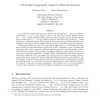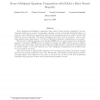11 search results - page 2 / 3 » How Many Oblivious Transfers Are Needed for Secure Multipart... |
ASIACRYPT
2008
Springer
13 years 7 months ago
2008
Springer
In an oblivious transfer (OT) protocol, a Sender with messages M1, . . . , MN and a Receiver with indices 1, . . . , k [1, N] interact in such a way that at the end the Receiver ...
ASIACRYPT
2007
Springer
13 years 11 months ago
2007
Springer
An extended abstract of this paper appears in Kaoru Kurosawa (Ed.): Advances in Cryptology ASIACRYPT 2007, volume 4833 of Lecture Notes in Computer Science, pages 265–282, Spring...
FSTTCS
2009
Springer
13 years 12 months ago
2009
Springer
ABSTRACT. A non-local box is an abstract device into which Alice and Bob input bits x and y respectively and receive outputs a and b respectively, where a, b are uniformly distribu...
FOCS
2006
IEEE
13 years 11 months ago
2006
IEEE
Secret sharing and multiparty computation (also called “secure function evaluation”) are fundamental primitives in modern cryptography, allowing a group of mutually distrustfu...
PKC
2010
Springer
13 years 9 months ago
2010
Springer
In many practical settings, participants are willing to deviate from the protocol only if they remain undetected. Aumann and Lindell introduced a concept of covert adversaries to f...


